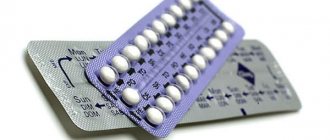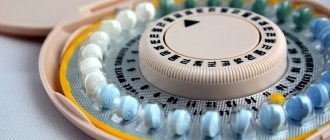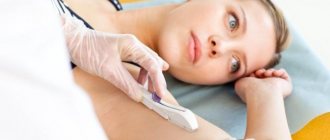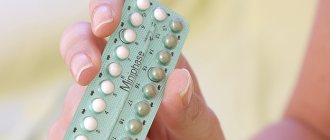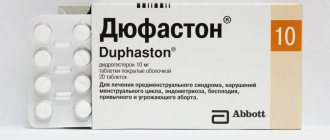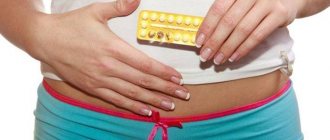Pharmacotherapeutic group and properties
The medication belongs to monophasic low-dose oral estrogen-gestagen contraceptives. The gestagenic component of the drug, gestodene, affects a woman’s body more strongly than the natural hormone progesterone, which is produced by the corpus luteum. Ethinyl estradiol is a synthetic derivative of natural estrogens . The contraceptive effect of the drug is due to its ability to suppress the process of egg maturation, inhibit the susceptibility of the uterine cavity mucosa to the blastocyst and increase the viscosity of cervical mucus.
Pros and cons of OK Logest
The combined monophasic contraceptive Logest has a number of advantages, but is not without its disadvantages. The main advantages of Logest and its disadvantages are presented below.
Effectively protects against unplanned pregnancy
Helps normalize the balance of sex hormones
Eliminates symptoms of PMS
Often causes adverse reactions
It is necessary to strictly adhere to the dosage schedule
You can get better from taking Logest
If a woman follows the rules for taking the medication, it is impossible to become pregnant while taking Logest tablets.
Indications and contraindications for use
The main indication for prescribing the oral combined monophasic contraceptive Logest is the prevention of unplanned pregnancy. In addition, this drug can be used to normalize the balance of sex hormones and treat dysmenorrhea, when a woman has pronounced manifestations of premenstrual syndrome and has diseases such as endometriosis and uterine fibroids. Contraindications for the use of Logest include:
- severe hypertriglyceridemia;
- individual lactose intolerance, glucose-galactose malabsorption;
- confirmed, suspected or previously diagnosed breast cancer;
- individual intolerance to one of the components of the drug;
- severe decompensated liver and kidney diseases;
- history of thromboembolic complications;
- porphyria;
- hyperplastic changes in the mucous membrane of the uterine cavity (endometrium);
- previous myocardial infarction or cerebral stroke.
Instructions for using birth control pills Logest
You need to take 1 tablet of this remedy every day at the same time. The medication should be taken for 21 days, which corresponds to the number of tablets in the package. After this, you need to take a break of 7 days and start drinking the hormonal drug Logest from a new package.
During the break, a woman experiences intermenstrual bleeding from the genital tract, called withdrawal bleeding. This condition is normal.
If a woman takes Logest tablets for the first time, then this must be done on the first day of menstruation. As an exception, Logest hormonal tablets can be started on days 2-5 of the cycle, but during the next week it is necessary to use additional methods of protection (male condoms).
What to do if you miss it?
If no more than 12 hours have passed since the missed dose, that woman should immediately take the missed tablet, and the effectiveness of Logest will not be affected. When more than 12 hours have passed since the missed pill, the contraceptive properties of the drug are reduced, so the woman must take the missed pill immediately and, over the next 7 days, use additional methods of protection against unplanned pregnancy (male condoms). Pregnancy after discontinuation of Logest may occur in the next cycle.
How to switch from other contraceptives?
If a woman has previously used an oral tablet contraceptive, the package of which contained 28 tablets, then she must switch to taking Logest the very next day after taking the last tablet of the previous contraceptive. If you previously used a contraceptive with 21 tablets in the package, then you should start taking Logest the next day after completing the week-long break. If you have previously taken a contraceptive drug containing only a progestogen component, then switching to Logest is permissible immediately, without any interruptions. If you have previously used an intrauterine device or a hormonal implant, then it is permissible to start taking Logest immediately after removal of the IUD or implant. If you have previously used contraceptives in injectable form, then you should begin switching to a tablet drug on the day of the expected next injection.
How to take after an early abortion?
If the abortion was performed during the first trimester of gestation, then you can start taking an oral combined contraceptive on the day of artificial termination of gestation. If the pregnancy was artificially terminated in the 2nd trimester, then you should start taking birth control pills on days 21-28 of the cycle. If the contraceptive was started later, then over the next 7 days, it is recommended to use male condoms.
After Logest there are no periods: why?
If your period does not come after taking Logest, first of all you need to exclude pregnancy using an ultrasound and a hCG test. If pregnancy does not occur, you can continue taking the drug as usual.
It is possible that there is no menstruation due to prolonged, that is, continuous use of the drug in order to delay the onset of menstruation. If the drug was taken as usual, the absence of menstruation may be due to endometrial atrophy.
If, after stopping Logest, you do not have your period during a seven-day break, observation is necessary for three months, and then, if menstruation does not appear, an examination (ultrasound of the pelvic organs, blood test for FSH, LH, TSH, prolactin). Depending on the results obtained during the examination, treatment is adjusted. For example, amenorrhea may result from hypothyroidism, and high concentrations of thyroid-stimulating hormone increase prolactin secretion. And hyperprolactinemia suppresses ovulation due to its inhibitory effect on FSH and LH.
In addition, taking oral contraceptives itself causes hyperprolactinemia. Another reason that there is no menstruation after discontinuation of Logest is hypogonadotropic ovarian failure. It also occurs due to a decrease in the concentration of FSH and LH, which cannot affect the ovary and trigger the production of sex hormones in it: estrogen and progesterone.
Menstruation on Logest takes a long time and does not stop
Menstruation does not end for a long time while taking Logest, often due to the small dose of the estrogen component in the drug, since it is a microdosed drug (contains 0.02 mg ethinyl estradiol). The level of estrogen in a woman’s blood plasma is higher than in the drug, and the body has not yet had time to get used to the new doses.
If your period becomes heavy bleeding, you need to stop it. For hormonal hemostasis, you can use monophasic low-dose drugs containing 30 mcg of ethinyl estradiol (for example, Regulon) according to the scheme: 4 tablets on the first day, 3 tablets on the second, 2 tablets on the third day of administration, and then one tablet per day on within 21 days.
How to take Logest to delay menstruation?
With the help of hormonal contraceptives, you can regulate the menstrual cycle, including delaying the day of your next menstruation. To do this, you need to start taking a new package of Logest immediately after the previous one has ended without a break for menstruation. When taking tablets from the second package, spotting may occur. You can take the tablets without a break for as long as you need or until the second package is finished. Then, after a seven-day break, you can start taking tablets from the third package.
Valentina Lyapunova, general practitioner, especially for Mirmam.pro
Side effects
Regardless of the general state of health, the presence or absence of chronic diseases, any woman taking the hormonal drug Logest may experience the following adverse reactions to the contraceptive:
- abdominal pain and nausea;
- the effect of Logest on weight is noted;
- migraine;
- swelling;
- diarrhea;
- engorgement of the mammary glands and their soreness;
- allergic reactions, urticaria;
- decreased libido;
- intermenstrual discharge from the genital tract;
- erythema nodosum;
- thromboembolic complications;
- sudden mood swings, apathy, depression, unmotivated irritability.
If one or more side effects occur, it is recommended to stop taking Logest tablets and seek advice from your gynecologist. In most cases, the question of replacing an oral contraceptive is raised.
If a woman follows the regimen of taking Logest tablets, then she will not encounter an overdose of hormonal components. In case of overdose, symptoms such as heavy bleeding, vomiting and nausea develop. It is strictly forbidden for girls under 18 years of age and before menarche to take this drug . Otherwise, there is a high risk of breakthrough bleeding. As a consequence of discontinuing Logest, a hormonal imbalance may develop that requires medication correction.
pregnancy while taking Logest
Recommendations for patients preparing for IVF.
Introduction. We advise you to familiarize yourself with these recommendations before starting your IVF treatment.
This will save you from having to ask yourself a lot of questions, the answers to which can be difficult to find. It is important to remember that no two patients are identical, there is no single examination and treatment regimen suitable for everyone, several IVF attempts can differ significantly even in the same patient. The tactics of conducting each IVF attempt, preparation for it, and the choice of drugs are determined individually. This is why you may find that, for example, your second IVF attempt will differ from the first, as well as from what may be offered to other patients. It is precisely because of this that you should not compare the results of the examinations and the methods used with what is recommended for other patients, even if, as you think, a lot is the same. We should not forget that for many patients the need to resort to IVF is a strong psychological stress, and discussing such problems can be very unpleasant for them. With a high degree of probability, we can assume that you will be assigned some kind of preliminary examination. To optimize your visit to the clinic for these tests, it is recommended to find out in advance what tests will be needed, whether an appointment is required, what time you need to be at the clinic, whether these tests are performed on an empty stomach, and whether the results of these examinations depend on the day of the menstrual cycle. Infertility treatment using assisted reproductive technologies is carried out on the basis of your written statements, as well as informed consents, which must be filled out by you before the start of treatment. What can increase the effectiveness of treatment
For women:
- Stop taking medications and bioactive food supplements on your own (“for general health”). If you are prescribed any treatment, please inform us before starting your IVF cycle.
- take multivitamins, preferably designed for pregnancy (prenatal vitamins), vitamin E, folic acid (necessity and dosage regimen - at the discretion of your doctor).
- limit or stop smoking and drinking alcohol, as these factors can reduce the likelihood of pregnancy and increase the risk of miscarriage.
- Limit your intake of drinks containing caffeine.
- Do not start a new diet or try to lose weight during an IVF treatment cycle. During this period, it is best to eat a balanced, nutritious diet.
- abstain from sexual activity 3-4 days before follicle puncture, as well as during the period after embryo transfer until pregnancy is diagnosed. If pregnancy occurs, sexual rest should be maintained for several more weeks.
- Avoid significant physical activity and intense sports. It is better to avoid extreme sports, horse riding or cycling during this period. Moderate physical activity and walking in the fresh air will be beneficial.
- Refuse to visit the bathhouse, sauna, or take baths for this period.
For men:
- An increase in temperature for several days due to any illness, such as a cold, can negatively affect the sperm count. If you have had a fever or if you have had an illness, even in a mild form, at the beginning or during treatment, notify your doctor.
- Visiting a sauna or taking a hot bath before treatment is not advisable due to the negative impact of high temperatures on spermatogenesis, as well as on sperm quality. Refrain from visiting a bathhouse or sauna 1 – 2 months before starting IVF.
- Try to stop smoking and drinking alcohol 2-3 months before starting IVF infertility treatment.
- If you are a carrier of any viral infection, then if the viral process worsens, if external manifestations appear, notify your doctor.
- If you visit a sports club, then you should not start a new program or learn new sports.
- American experts recommend limiting recreational running to a total of 35 kilometers per week during IVF treatment.
- Despite the lack of a reliably proven relationship between wearing tight underwear and poor sperm quality, experts from the WHO and the American Society for Reproductive Medicine recommend refraining from wearing such underwear during the IVF program.
- Sexual rest for at least 3, but no more than 6-7 days, before the day of transvaginal puncture of the follicles and, accordingly, sperm donation.
Some explanations for infertility treatment using IVF: Oddly enough, treatment can begin a month earlier than the planned treatment cycle. The preparation methods described below are not mandatory; their use is determined individually. You may be recommended to take hormonal contraceptives belonging to the class of monophasic combined oral contraceptives (eg, Logest, Silest, Femoden). These drugs are prescribed to suppress ovulation in this cycle, prevent the appearance of ovarian cysts, better prepare the endometrium for treatment, and make the onset of menstruation more predictable, which allows for more accurate treatment planning. If hormonal contraceptives are not prescribed, an ovulation test (clearplan, ovuplan, frau test) may be recommended. A few days after confirmation of ovulation, you will be asked to undergo an ultrasound examination to assess the quality of the endometrium and the condition of the ovaries. It is also common to perform a trial “embryo transfer” in the previous cycle. Of course, no embryos will be used in this case. To ensure that the actual embryo transfer procedure is as effective as possible, in the middle of the second phase of the menstrual cycle, the doctor simulates the embryo transfer procedure by passing a special embryo catheter through the cervical canal. This will allow you to clarify in advance the direction of the cervical canal, possible bends, and determine the likely difficulties during its passage. Some clinics do this for all patients without fail, some do not use this manipulation, this is largely determined by the preference of your doctor, as well as your medical history and the condition of the cervix. All medications used to stimulate the ovaries are produced in the form of injections. Every day, preferably at the same time, you will need to make subcutaneous injections into the abdomen in the navel area if medications such as diferelin, decapeptyl, puregon, gonal-f, follistim, orgalutran, cetrotide or antagon are prescribed. You will have to master intramuscular injections if you are prescribed one of the following drugs: Pergonal, Menogon, Metrodin, Bravel, Repronex. When you buy these medications, the package will contain an ampoule with sterile water and a bottle of powder. To avoid confusion, ask the nurse at the clinic to explain how to dilute the powdered medicine and give the injection. During this course of injections, you will need to come to the doctor every 2-3 days for an ultrasound examination to assess how the ovaries react, how many follicles have appeared and how they are growing. This is called ultrasound monitoring. This is done so that you receive the minimum necessary dose of medication, sufficient to obtain several good mature eggs. Gradually, closer to the end of the stimulation, you may begin to feel heaviness in the lower abdomen, a feeling of fullness in the abdomen may appear - these are quite likely consequences of treatment, because the ovaries often enlarge. If this happens, be sure to inform your doctor.
How to prepare medicine and give an injection
- Wash your hands well.
- Prepare everything you need for the injection: medicine, an alcohol wipe for injections (sold in all pharmacies), a separate needle from the syringe, an insulin or regular syringe.
- Open the ampoule with sterile water, put a needle on the syringe, draw water into the syringe. To collect all the water from the ampoule, lower the syringe needle to the bottom of the ampoule.
- Remove the plastic plate from the lid of the medicine bottle, pierce the rubber stopper with the needle without removing it from the syringe and inject water inside.
- The powder dissolves almost instantly, resulting in a clear solution, without foam or clots. If the solution is cloudy or dissolves unevenly, it is better not to use this portion.
- Without removing the needle, turn the bottle over, pull out the needle so that only the tip of the needle remains inside the bottle and pull the solution with the medicine into the syringe. If you are prescribed several ampoules of medicine at the same time, for example, 3 ampoules of Puregon, then simply repeat steps 4 – 6 with the same water for injection. This way, you will have a small volume of liquid containing the required amount of medication and you will be spared the need to administer excess water with the medication.
- Disconnect the syringe from this needle and attach a new sterile needle to it.
- Turn the syringe vertically with the needle up and, after gently tapping the syringe with your finger (so that air bubbles collect at the needle), carefully and lightly press the syringe plunger so that the air comes out of the syringe.
- Select the injection site. For subcutaneous injections, use areas of the abdomen on both sides of the navel, right and left, alternating sides every day.
- Wipe the selected area with an alcohol wipe several times.
- Take the syringe with one hand and hold it at an angle to the skin of the abdomen, with the thumb and forefinger of the other hand, grab the fold of skin of the treated area near the navel.
- Quickly insert the needle into the skin to the base, slowly inject the solution with the medicine.
- Release the skin and apply pressure to the injection site with an alcohol pad before removing the needle.
Remember that the last injection, the final stage of controlled stimulation of superovulation - an injection of human chorionic gonadotropin (pregnyl, prophasy, choragon) necessary for the final maturation of eggs, as well as to prevent ovulation, should be done 34 - 37 hours before the puncture. In this case, the effect of the drug is most optimal. This is a very important condition, which largely ensures the production of high-quality eggs. Accordingly, this injection is done in the evening the day before the puncture. For example, if the puncture is scheduled for 09.00 on Monday morning, then the optimal time for the injection will be 23.00 on Saturday. Preparation for follicle puncture. The next 3-4 days before the puncture - sexual rest. The day before the puncture, have a light lunch and tea in the evening. In the morning on the day of the puncture, you cannot eat or drink. It is advisable not to smoke or chew gum on this day. On the day of the puncture, at the clinic you will be taken to a room where you will change clothes, an anesthesiologist will talk to you, after which you will be taken to the operating room. Follicular puncture is performed under general intravenous anesthesia. On average, a puncture takes 15–40 minutes, depending on the response of the ovaries and the number of follicles. During the puncture or after, your spouse donates sperm. After the puncture, you will be taken to the ward, where you will spend 1 – 2 hours. During this time, you will finally “wake up” after anesthesia, come to your senses, your doctor will tell you how the puncture went, how many eggs were obtained, what the quality of the sperm is, and you will be given further recommendations. Your spouse must wait for a message that the collected sperm is suitable for further embryological work, otherwise a second sperm donation may be required. Some time after the puncture, when you already feel normal, you can eat and drink tea. On this day, given the anesthesia, patients are not allowed to drive on their own. This evening, in addition to driving, it is not recommended to drink alcoholic beverages, make important decisions, or be sexually active. At home after the puncture, it is better to rest and lie down. This evening you may have tension, pain in the lower abdomen, there may be slight bleeding from the genital tract, and there may be a slight increase in temperature. Tell your doctor immediately about the following symptoms:
- Significant and prolonged increase in temperature
- Severe vaginal bleeding
- Severe or increasing feeling of discomfort, feeling of fullness in the abdomen
- Increased belly size
- Difficulty or painful urination, burning sensation when urinating
- Severe bowel movements
- Nausea, vomiting
- Sharp or shooting pain in the lower abdomen
- Unusual back pain
From the day of the puncture, you will be prescribed new medications aimed at maintaining the second half of the menstrual cycle, promoting the progression of the pregnancy. Embryo transfer is usually carried out 2-3 or 5-6 days after puncture. Transfer time is not as important as puncture time. This painless procedure is performed with a special soft, thin catheter. Before the manipulation, in case of anxiety, you can take a sedative; often, in addition, no-shpa is prescribed. After you sit on the chair, a speculum will be inserted into the vagina, the vagina and cervix will be treated with sterile water or saline, then under ultrasound control a catheter will be inserted into the uterine cavity, through which your embryos will be delivered to the uterine cavity. The number of embryos transferred in each case is discussed individually and must be agreed with you. After the transfer, the embryologist must examine the catheter under a microscope to check that there are no embryos left in the catheter. After the embryo transfer has been completed, you can be sent home immediately, as it has been proven that this does not reduce the likelihood of pregnancy. although most clinics still prefer to give you the opportunity to lie down for 1–2 hours after the procedure. On the way home or already at home, you may have slight bleeding - you should not be afraid of this, of course, this is not the “loss” of embryos from the uterine cavity. After embryo transfer it is not recommended:
- Take a hot bath or go to a swimming pool for the first 2 days after the transfer
- Use sanitary tampons
- Intimate relationships
- Sports activities
- Mastering new sports
- Take any non-prescribed medications
- Lifting weights
Try to keep yourself busy during the two-week period between embryo transfer and pregnancy test. Pregnancy test. Delivered 13–14 days after embryo transfer. To do this, you need to come to the clinic on an empty stomach and donate blood from a vein. Mostly, clearly positive or negative results are obtained. If you receive a negative (negative) answer, this means that, unfortunately, pregnancy did not occur in this attempt. The first thing you need to do is not to despair and remain confident that you will still get pregnant, for example, in your next attempt. And this time you stop taking all prescribed medications, wait for your menstruation and after a while you come for a second consultation for further recommendations. Menstruation that occurs during the withdrawal of these drugs may differ from normal menstruation - be longer, more painful, more abundant, or may pass as usual. If the answer is positive, please accept congratulations on your pregnancy. You definitely need to continue taking all medications. After a week or 10 days – depending on the clinic’s policy – you come for an ultrasound examination. This is extremely important, since in this case the fertilized egg will be detected, its location will be determined (uterine or ectopic pregnancy), and also, if several embryos were transferred, how many embryos have “taken root” and are developing. But sometimes there are “weakly positive” answers. This may be due to the following:
- Late but normal embryo implantation
- Lost pregnancy
- Ectopic (ectopic) pregnancy
- Laboratory error.
In all of the above cases, further ultrasound and hormonal monitoring is extremely important to clarify this situation. —
Recommendations for patients preparing for IVF.
Introduction. We advise you to familiarize yourself with these recommendations before starting your IVF treatment. This will save you from the need to ask yourself many questions, the search for answers to which can be difficult. It is important to remember that no two patients are the same, there is no single examination and treatment scheme suitable for everyone, several IVF attempts can differ significantly even in the same patient patients. The tactics of conducting each IVF attempt, preparation for it, and the choice of drugs are determined individually. This is why you may find that, for example, your second IVF attempt will differ from the first, as well as from what may be offered to other patients. It is precisely because of this that you should not compare the results of the examinations and the methods used with what is recommended for other patients, even if, as you think, a lot is the same. We should not forget that for many patients the need to resort to IVF is a strong psychological stress, and discussing such problems can be very unpleasant for them. With a high degree of probability, we can assume that you will be assigned some kind of preliminary examination. To optimize your visit to the clinic for these tests, it is recommended to find out in advance what tests will be needed, whether an appointment is required, what time you need to be at the clinic, whether these tests are performed on an empty stomach, and whether the results of these examinations depend on the day of the menstrual cycle. Infertility treatment using assisted reproductive technologies is carried out on the basis of your written statements, as well as informed consents, which must be filled out by you before the start of treatment. —
What can increase the effectiveness of treatment
For women:
- Stop taking medications and bioactive food supplements on your own (“for general health”). If you are prescribed any treatment, please inform us before starting your IVF cycle.
- take multivitamins, preferably designed for pregnancy (prenatal vitamins), vitamin E, folic acid (necessity and dosage regimen - at the discretion of your doctor).
- limit or stop smoking and drinking alcohol, as these factors can reduce the likelihood of pregnancy and increase the risk of miscarriage.
- Limit your intake of drinks containing caffeine.
- Do not start a new diet or try to lose weight during an IVF treatment cycle. During this period, it is best to eat a balanced, nutritious diet.
- abstain from sexual activity 3-4 days before follicle puncture, as well as during the period after embryo transfer until pregnancy is diagnosed. If pregnancy occurs, sexual rest should be maintained for several more weeks.
- Avoid significant physical activity and intense sports. It is better to avoid extreme sports, horse riding or cycling during this period. Moderate physical activity and walking in the fresh air will be beneficial.
- Refuse to visit the bathhouse, sauna, or take baths for this period.
For men:
- An increase in temperature for several days due to any illness, such as a cold, can negatively affect the sperm count. If you have had a fever or if you have had an illness, even in a mild form, at the beginning or during treatment, notify your doctor.
- Visiting a sauna or taking a hot bath before treatment is not advisable due to the negative impact of high temperatures on spermatogenesis, as well as on sperm quality. Refrain from visiting a bathhouse or sauna 1 – 2 months before starting IVF.
- Try to stop smoking and drinking alcohol 2-3 months before starting IVF infertility treatment.
- If you are a carrier of any viral infection, then if the viral process worsens, if external manifestations appear, notify your doctor.
- If you visit a sports club, then you should not start a new program or learn new sports.
- American experts recommend limiting recreational running to a total of 35 kilometers per week during IVF treatment.
- Despite the lack of a reliably proven relationship between wearing tight underwear and poor sperm quality, experts from the WHO and the American Society for Reproductive Medicine recommend refraining from wearing such underwear during the IVF program.
- Sexual rest for at least 3, but no more than 6-7 days, before the day of transvaginal puncture of the follicles and, accordingly, sperm donation.
—
Some explanations on infertility treatment using IVF:
Oddly enough, treatment may begin a month earlier than the planned treatment cycle. The preparation methods described below are not mandatory; their use is determined individually. You may be recommended to take hormonal contraceptives belonging to the class of monophasic combined oral contraceptives (eg, Logest, Silest, Femoden). These drugs are prescribed to suppress ovulation in this cycle, prevent the appearance of ovarian cysts, better prepare the endometrium for treatment, and make the onset of menstruation more predictable, which allows for more accurate treatment planning. If hormonal contraceptives are not prescribed, an ovulation test (clearplan, ovuplan, frau test) may be recommended. A few days after confirmation of ovulation, you will be asked to undergo an ultrasound examination to assess the quality of the endometrium and the condition of the ovaries. It is also common to perform a trial “embryo transfer” in the previous cycle. Of course, no embryos will be used in this case. To ensure that the actual embryo transfer procedure is as effective as possible, in the middle of the second phase of the menstrual cycle, the doctor simulates the embryo transfer procedure by passing a special embryo catheter through the cervical canal. This will allow you to clarify in advance the direction of the cervical canal, possible bends, and determine the likely difficulties during its passage. Some clinics do this for all patients without fail, some do not use this manipulation, this is largely determined by the preference of your doctor, as well as your medical history and the condition of the cervix. All medications used to stimulate the ovaries are produced in the form of injections. Every day, preferably at the same time, you will need to make subcutaneous injections into the abdomen in the navel area if medications such as diferelin, decapeptyl, puregon, gonal-f, follistim, orgalutran, cetrotide or antagon are prescribed. You will have to master intramuscular injections if you are prescribed one of the following drugs: Pergonal, Menogon, Metrodin, Bravel, Repronex. When you buy these medications, the package will contain an ampoule with sterile water and a bottle of powder. To avoid confusion, ask the nurse at the clinic to explain how to dilute the powdered medicine and give the injection. During this course of injections, you will need to come to the doctor every 2-3 days for an ultrasound examination to assess how the ovaries react, how many follicles have appeared and how they are growing. This is called ultrasound monitoring. This is done so that you receive the minimum necessary dose of medication, sufficient to obtain several good mature eggs. Gradually, closer to the end of the stimulation, you may begin to feel heaviness in the lower abdomen, a feeling of fullness in the abdomen may appear - these are quite likely consequences of treatment, because the ovaries often enlarge. If this happens, be sure to inform your doctor.
Recommendations for patients preparing for IVF
What can increase the effectiveness of treatment
How to prepare medicine and give an injection
Preparation for follicle puncture
On the day of puncture
Tell your doctor immediately about the following symptoms:
How to prepare medicine and give an injection
- Wash your hands well.
- Prepare everything you need for the injection: medicine, an alcohol wipe for injections (sold in all pharmacies), a separate needle from the syringe, an insulin or regular syringe.
- Open the ampoule with sterile water, put a needle on the syringe, draw water into the syringe. To collect all the water from the ampoule, lower the syringe needle to the bottom of the ampoule.
- Remove the plastic plate from the lid of the medicine bottle, pierce the rubber stopper with the needle without removing it from the syringe and inject water inside.
- The powder dissolves almost instantly, resulting in a clear solution, without foam or clots. If the solution is cloudy or dissolves unevenly, it is better not to use this portion.
- Without removing the needle, turn the bottle over, pull out the needle so that only the tip of the needle remains inside the bottle and pull the solution with the medicine into the syringe. If you are prescribed several ampoules of medicine at the same time, for example, 3 ampoules of Puregon, then simply repeat steps 4 – 6 with the same water for injection. This way, you will have a small volume of liquid containing the required amount of medication and you will be spared the need to administer excess water with the medication.
- Disconnect the syringe from this needle and attach a new sterile needle to it.
- Turn the syringe vertically with the needle up and, after gently tapping the syringe with your finger (so that air bubbles collect at the needle), carefully and lightly press the syringe plunger so that the air comes out of the syringe.
- Select the injection site. For subcutaneous injections, use areas of the abdomen on both sides of the navel, right and left, alternating sides every day.
- Wipe the selected area with an alcohol wipe several times.
- Take the syringe with one hand and hold it at an angle to the skin of the abdomen, with the thumb and forefinger of the other hand, grab the fold of skin of the treated area near the navel.
- Quickly insert the needle into the skin to the base, slowly inject the solution with the medicine.
- Release the skin and apply pressure to the injection site with an alcohol pad before removing the needle.
Remember that the last injection, the final stage of controlled stimulation of superovulation - an injection of human chorionic gonadotropin (pregnyl, prophasy, choragon) necessary for the final maturation of eggs, as well as to prevent ovulation, should be done 34 - 37 hours before the puncture. In this case, the effect of the drug is most optimal. This is a very important condition, which largely ensures the production of high-quality eggs. Accordingly, this injection is done in the evening the day before the puncture. For example, if the puncture is scheduled for 09.00 on Monday morning, then the optimal time for the injection will be 23.00 on Saturday.
Recommendations for patients preparing for IVF
What can increase the effectiveness of treatment
Some explanations on the treatment of infertility using IVF
Preparation for follicle puncture
On the day of puncture
Tell your doctor immediately about the following symptoms:
Preparation for follicle puncture.
The next 3-4 days before the puncture - sexual rest. The day before the puncture, have a light lunch and tea in the evening. On the morning of the puncture, you should neither eat nor drink. It is advisable not to smoke or chew gum on this day.
Recommendations for patients preparing for IVF
What can increase the effectiveness of treatment
Some explanations on the treatment of infertility using IVF
How to prepare medicine and give an injection
On the day of puncture
Tell your doctor immediately about the following symptoms:
On the day of the puncture.
At the clinic, you will be taken to a room where you will change clothes, an anesthesiologist will talk to you, after which you will be taken to the operating room. Follicular puncture is performed under general intravenous anesthesia. On average, a puncture takes 15–40 minutes, depending on the response of the ovaries and the number of follicles. During the puncture or after, your spouse donates sperm. After the puncture, you will be taken to the ward, where you will spend 1 – 2 hours. During this time, you will finally “wake up” after anesthesia, come to your senses, your doctor will tell you how the puncture went, how many eggs were obtained, what the quality of the sperm is, and you will be given further recommendations. Your spouse must wait for a message that the collected sperm is suitable for further embryological work, otherwise a second sperm donation may be required. Some time after the puncture, when you already feel normal, you can eat and drink tea. On this day, given the anesthesia, patients are not allowed to drive on their own. This evening, in addition to driving, it is not recommended to drink alcoholic beverages, make important decisions, or be sexually active. At home after the puncture, it is better to rest and lie down. This evening you may have tension, pain in the lower abdomen, there may be slight bleeding from the genital tract, and there may be a slight increase in temperature.
Recommendations for patients preparing for IVF
What can increase the effectiveness of treatment
Some explanations on the treatment of infertility using IVF
How to prepare medicine and give an injection
Preparation for follicle puncture
Tell your doctor immediately about the following symptoms
–
Tell your doctor immediately about the following symptoms:
- Significant and prolonged increase in temperature
- Severe vaginal bleeding
- Severe or increasing feeling of discomfort, feeling of fullness in the abdomen
- Increased belly size
- Difficulty or painful urination, burning sensation when urinating
- Severe bowel movements
- Nausea, vomiting
- Sharp or shooting pain in the lower abdomen
- Unusual back pain
From the day of the puncture, you will be prescribed new medications aimed at maintaining the second half of the menstrual cycle, promoting the progression of the pregnancy. Embryo transfer is usually carried out 2-3 or 5-6 days after puncture. Transfer time is not as important as puncture time. This painless procedure is performed with a special soft, thin catheter. Before the manipulation, in case of anxiety, you can take a sedative; often, in addition, no-shpa is prescribed. After you sit on the chair, a speculum will be inserted into the vagina, the vagina and cervix will be treated with sterile water or saline, then under ultrasound control a catheter will be inserted into the uterine cavity, through which your embryos will be delivered to the uterine cavity. The number of embryos transferred in each case is discussed individually and must be agreed with you. After the transfer, the embryologist must examine the catheter under a microscope to check that there are no embryos left in the catheter. After the embryo transfer has been completed, you can be sent home immediately, as it has been proven that this does not reduce the likelihood of pregnancy. although most clinics still prefer to give you the opportunity to lie down for 1–2 hours after the procedure. On the way home or already at home, you may have slight bleeding - you should not be afraid of this, of course, this is not the “loss” of embryos from the uterine cavity. After embryo transfer it is not recommended:
- Take a hot bath or go to a swimming pool for the first 2 days after the transfer
- Use sanitary tampons
- Intimate relationships
- Sports activities
- Mastering new sports
- Take any non-prescribed medications
- Lifting weights
Try to keep yourself busy during the two-week period between embryo transfer and pregnancy test. Pregnancy test. Delivered 13–14 days after embryo transfer. To do this, you need to come to the clinic on an empty stomach and donate blood from a vein. Mostly, clearly positive or negative results are obtained. If you receive a negative (negative) answer, this means that, unfortunately, pregnancy did not occur in this attempt. The first thing you need to do is not to despair and remain confident that you will still get pregnant, for example, in your next attempt. And this time you stop taking all prescribed medications, wait for your menstruation and after a while you come for a second consultation for further recommendations. Menstruation that occurs during the withdrawal of these drugs may differ from normal menstruation - be longer, more painful, more abundant, or may pass as usual. If the answer is positive, please accept congratulations on your pregnancy. You definitely need to continue taking all medications. After a week or 10 days – depending on the clinic’s policy – you come for an ultrasound examination. This is extremely important, since in this case the fertilized egg will be detected, its location will be determined (uterine or ectopic pregnancy), and also, if several embryos were transferred, how many embryos have “taken root” and are developing. But sometimes there are “weakly positive” answers. This may be due to the following:
- Late but normal embryo implantation
- Lost pregnancy
- Ectopic (ectopic) pregnancy
- Laboratory error.
In all of the above cases, further ultrasound and hormonal monitoring is extremely important to clarify this situation.
Tablet interactions
Like any hormonal drug, Logest can actively interact with certain groups of medications, ethyl alcohol and components of tobacco smoke.
With other drugs
In order not to create additional stress on the liver and not to reduce the contraceptive effect of the hormonal drug, it is not recommended to combine its use with the following types of medications:
- Rifampicin;
- Carbamazepine;
- Preparations containing St. John's wort extract;
- Oxcarbazepine;
- Felbamate;
- Griseofulvin;
- Topiramate;
- Intraconazole;
- Fluconazole;
- Macrolides;
- Verapamil;
- Erythromycin;
- Clarithromycin.
In addition, while taking Logest, it is not recommended to drink grapefruit juice, as it can enhance the effect of one of the active components of the drug.
With alcohol
The hormonal components of any oral contraceptive create additional stress on the liver. Alcohol has a similar effect, even in minimal dosages. That is why it is strictly forbidden to combine the use of hormonal contraceptives with alcohol consumption. Even minimal doses of ethyl alcohol in combination with birth control pills can cause serious harm to a woman’s body.
With smoking
Substances contained in tobacco smoke negatively affect the condition of the cardiovascular system and also increase the risk of blood clots. If a woman combines birth control pills with smoking, she is at high risk of developing blood clots and thromboembolic complications. At the stage of taking oral contraception, it is recommended to completely stop smoking.
Logest's analogs
Drugs that can be called analogues of the combined oral contraceptive Logest include:
- Dinoret. The medication contains ethinyl estradiol and dienogest. Dinoret is an analogue of Logest in terms of method of administration and indications.
- Regulon. The active ingredients of the drug include ethinyl estradiol and desogestrel. This medication is analogous to logistics in its method of administration and indications.
- Lindineth. By analogy with Logest, this drug contains ethinyl estradiol and gestodene. That is why Lindinet is an absolute analogue of Logest.
- Yarina. The drug consists of ethinyl estradiol and drospirenone. Yarina can be classified as an analogue of Logest in terms of indications and method of administration.
Which is better Logest or Jess?
Both drugs have a combined hormonal composition, but the contraceptive effect of Logest is due to the influence of ethinyl estradiol and gestodene, and the contraceptive properties of the drug Jess are due to the content of drospirenone and ethinyl estradiol. Both medications have the same contraceptive properties. Each package of Logest contains 21 active tablets, and the package of Jess contains 28 tablets, 7 of which are placebo. Jess is contraindicated in women with adrenal insufficiency and severe kidney dysfunction. The drug cannot be prescribed to patients who have chronic pancreatitis with severe triglyceridemia.
Which is better Logest or Yarina?
Logest and Yarina contain ethinyl estradiol, but the content of this component in Logest is much lower. Both medications contain 21 active tablets. The drug Yarina can be used not only to protect against unplanned pregnancy, but also to correct hormonal levels. The components of this drug have a beneficial effect on menstrual function, improve the condition of the skin, hair and nails, and help fight acne. If a woman has not previously had experience taking oral contraception, then she is recommended to give preference to Logest (provided that there are no contraindications). In addition, women's reviews of Logest tablets are less negative than those of Yarina. Yarina is most often prescribed to women with severe symptoms of PMS, heavy and prolonged menstruation.
Logest, 75 mcg+20 mcg, film-coated tablets, 21 pcs.
In case of planned surgery, it is recommended to stop taking the drug at least 4 weeks before the operation and not to resume taking it for 2 weeks after the end of immobilization.
While taking medications that affect microsomal enzymes, and for 28 days after their discontinuation, you should additionally use a barrier method of contraception.
While taking antibiotics such as ampicillins and tetracyclines and for 7 days after their discontinuation, you should additionally use a barrier method of contraception.
If the period of use of the barrier method of protection ends later than the tablet in the package, you need to move on to the next package of Logest® without the usual break in taking the tablet.
If any of the conditions/risk factors listed below currently exist, the potential risks and expected benefits of Logest® treatment should be carefully weighed in each individual case and discussed with the woman before she decides to start taking the drug. If any of these conditions or risk factors worsen, intensify, or appear for the first time, a woman should consult her doctor, who may decide whether to discontinue the drug.
Diseases of the cardiovascular system
There is evidence of an increased incidence of venous and arterial thrombosis and thromboembolism when taking combined oral contraceptives.
However, the incidence of venous thromboembolism occurring with combined oral contraceptives is less than that associated with pregnancy (6 per 10,000 pregnant women per year).
In women taking combined oral contraceptives, extremely rare cases of thrombosis of other blood vessels, such as the hepatic, mesenteric, renal arteries and veins, the central retinal vein and its branches, have been described. The connection with the use of combined oral contraceptives has not been proven.
A woman should stop taking the drug and consult a doctor if symptoms of venous or arterial thrombosis or cerebrovascular disorders develop, which may include: unilateral leg pain and/or swelling; sudden severe chest pain with or without radiating to the left arm; sudden shortness of breath; sudden attack of cough; any unusual, severe, prolonged headache; sudden partial or complete loss of vision; diplopia; slurred speech or aphasia; dizziness; loss of consciousness with/or without a seizure; weakness or very significant loss of sensation that suddenly appears on one side or in one part of the body; movement disorders; symptoms of "acute abdomen".
The risk of thrombosis (venous and/or arterial) and thromboembolism increases: - with age; - in smokers (with an increase in the number of cigarettes or an increase in age, the risk further increases, especially in women over 35 years of age); in the presence of: - family history (i.e. venous or arterial thromboembolism ever in close relatives or parents at a relatively young age); in case of hereditary predisposition, the woman should be examined by an appropriate specialist to decide on the possibility of taking combined oral contraceptives; — obesity (body mass index more than 30 kg/m2); - dislipoproteinemia; - arterial hypertension; - migraine; — diseases of the heart valves; - atrial fibrillation; - prolonged immobilization, major surgery, any leg surgery or major trauma.
In these situations, it is advisable to stop using combined oral contraceptives (in the case of planned surgery, at least 4 weeks before it) and not to resume use for 2 weeks after the end of immobilization.
The increased risk of thromboembolism in the postpartum period should be taken into account.
Circulatory abnormalities may also occur in diabetes mellitus, systemic lupus erythematosus, hemolytic uremic syndrome, chronic inflammatory bowel disease (Crohn's disease or ulcerative colitis) and sickle cell anemia.
An increase in the frequency and severity of migraines during the use of combined oral contraceptives (which may precede cerebrovascular events) may be grounds for immediate discontinuation of these drugs.
Biochemical parameters that may be indicative of hereditary or acquired susceptibility to venous or arterial thrombosis include activated protein C resistance, hyperhomocysteinemia, antithrombin-III deficiency, protein C deficiency, protein S deficiency, the presence of antiphospholipid antibodies (anticardiolipin antibodies, lupus anticoagulant) .
Tumors
There are reports of an increased risk of developing cervical cancer with persistent human papillomavirus infection. Its connection with the use of combined oral contraceptives has not been proven. Controversy remains regarding the extent to which these findings relate to sexual behavior and barrier contraceptive use.
It was also found that there is a slightly increased relative risk of developing breast cancer diagnosed in women who used combined oral contraceptives. Its connection with the use of combined oral contraceptives has not been proven. The observed increased risk may be a consequence of earlier diagnosis of breast cancer in women using combined oral contraceptives.
In rare cases, the development of liver tumors has been observed during the use of combined oral contraceptives. The appearance of severe pain in the abdomen or signs of intra-abdominal bleeding, liver enlargement should be taken into account when making a differential diagnosis.
Other states
Women with hypertriglyceridemia (or a family history of this condition) may have an increased risk of developing pancreatitis while taking combined oral contraceptives.
Although slight increases in blood pressure have been described in many women taking combined oral contraceptives, clinically significant increases have rarely been reported. However, if a persistent, clinically significant increase in blood pressure develops while taking combined oral contraceptives, these drugs should be discontinued and treatment of arterial hypertension should be initiated. Taking combined oral contraceptives can be continued if normal blood pressure values are achieved with antihypertensive therapy.
The following conditions have been reported to develop or worsen both during pregnancy and while taking combined oral contraceptives, but their relationship with taking combined oral contraceptives has not been proven: jaundice and/or pruritus associated with cholestasis; formation of gallstones; porphyria; systemic lupus erythematosus; hemolytic uremic syndrome; chorea; herpes during pregnancy; hearing loss associated with otosclerosis. Cases of Crohn's disease and ulcerative colitis have also been described during the use of combined oral contraceptives.
Acute or chronic liver dysfunction may require discontinuation of combined oral contraceptives until liver function tests return to normal. Recurrent cholestatic jaundice, which develops for the first time during pregnancy or previous use of sex hormones, requires discontinuation of combined oral contraceptives.
Although combined oral contraceptives may have an effect on insulin resistance and glucose tolerance, there is no need to change the therapeutic regimen in diabetic patients using low-dose combined oral contraceptives (<0.05 mg ethinyl estradiol). However, women with diabetes mellitus should be carefully monitored while taking combined oral contraceptives.
Women prone to chloasma should avoid prolonged exposure to the sun and ultraviolet radiation while taking combined oral contraceptives.
Laboratory tests
Taking combined oral contraceptives may affect the results of some laboratory tests, including liver, kidney, thyroid, adrenal function, plasma transport protein levels, carbohydrate metabolism, coagulation and fibrinolysis parameters. Changes usually do not go beyond normal values.
Effect on the menstrual cycle
While taking combined oral contraceptives, irregular bleeding (spotting or breakthrough bleeding) may occur, especially during the first months of use. Therefore, any irregular bleeding should be assessed only after an adaptation period of approximately 3 cycles.
If irregular bleeding recurs or develops after previous regular cycles, careful evaluation should be performed to rule out malignancy or pregnancy.
Some women may not develop withdrawal bleeding during a break from taking the tablets. If combined oral contraceptives are taken as directed, the woman is unlikely to be pregnant. However, if combined oral contraceptives have not been taken regularly before, or if there are no 2 withdrawal bleedings in a row, pregnancy should be excluded before continuing to take the drug.
Medical examinations
Before starting to use the drug Logest®, a woman is recommended to undergo a thorough general medical and gynecological examination (including examination of the mammary glands and cytological examination of cervical mucus) and exclude pregnancy. In addition, disorders of the blood coagulation system should be excluded.
In case of long-term use, it is necessary to carry out control examinations, the frequency of which depends on the individual characteristics of the woman.
The woman should be warned that drugs such as Logest® do not protect against HIV infection (AIDS) and other sexually transmitted diseases!
There was no effect on the ability to drive a car or use machinery.
Doctors' opinions and reviews
Most reviews from women (,) who have taken or are taking a hormonal drug are positive. Reviews from gynecologists about the drug Logest are also positive.
The number of women who have experienced side effects from taking this medication is no more than 30%.
Despite the fact that the drug contains microdoses of sex hormones,
it is not recommended to prescribe it to yourself or take it despite existing contraindications . If adverse reactions occur, you should immediately seek advice from your gynecologist and replace Logest with an alternative drug.
The need to cancel Logest
The need to cancel Logest
Thus, those women who are not planning a pregnancy, when Logest is discontinued, must be protected by other reliable methods, for example, condoms, and be especially careful during this period.
Discontinuation of Logest is a prerequisite for long-term use (3-5 years), because otherwise taking the drug can lead to long-term restoration of reproductive functions when a woman decides to plan a pregnancy.
In any case, it is necessary to prescribe the drug, as well as make a decision on its discontinuation, together with your doctor, since self-medication can be extremely dangerous for a woman’s health.
